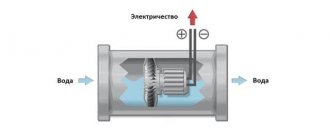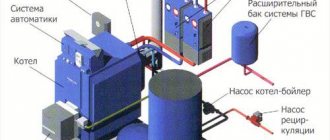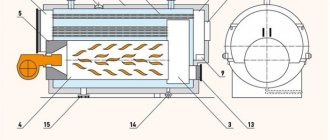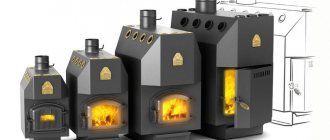Home |Useful articles |Double-circuit boiler in comparison with a single-circuit boiler and a gas water heater
Date: October 6, 2020
Comments: 0
In matters of water treatment in a private home, there is an eternal debate between universal and specialized approaches.
A universal view is to provide the home with heat and hot water using a double-circuit gas boiler that solves both problems simultaneously. The second option is specialization, when one unit (gas water heater) supplies hot water, and another (single-circuit boiler) handles home heating.
Specialists of the GradusPlus project, who have posted more than one material on their portal gradusplus.com about ways to save and optimize home heating, presented all the pros and cons of each of the schemes. They also determined why a single-circuit boiler and gas water heater are better and more comfortable, but not always.
Double-circuit gas boilers
Such boilers constructively separate the heating circuits of DHW and coolant, while sanitary water from the DHW circuit does not mix with technical water in the heating circuit. In our climate, they have two main operating modes:
- simultaneous maintenance of temperature in the hot water circuit and heating of the room in winter (or, if necessary, in cold summer);
- summer provision of hot water for household needs when heating is turned off (summer mode).
Operating modes can be controlled manually (for budget models) and automatically, depending on the situation outside the home (for advanced boilers). Double-circuit equipment is divided into two types: with a common or two separate heat exchangers.
Differences between boilers with one bithermal heat exchanger and two separate monothermal ones.
Gas double-circuit boiler
A double-circuit boiler is designed for separate heating of the coolant in the heating circuit and heating of running water for domestic hot water needs. Can be floor-mounted or wall-mounted depending on power. Its main advantages:
- one device instead of two;
- low price (relative to the purchase of two units);
- ease of installation;
- a large selection of models, both with automatic control and simpler ones.
Despite all the positive qualities of these devices, they have a number of features:
- The boiler operates continuously, even in the warm season, when the heating is turned off. This can lead to the formation of condensation inside the heating circuit and increased corrosion. The problem can be solved by timely prevention and water softening using various filters;
- Most double-circuit boilers do not operate simultaneously for DHW and heating, so while you are using hot water, the heating circuit does not warm up. This leads to increased fuel consumption for subsequent reheating of the coolant; with areas of heated premises exceeding 200 m2, this difference in costs can become noticeable;
- in order to use hot water in a comfortable mode, it is necessary to locate the consumption points as close as possible to the boiler, otherwise the heat losses will be significant;
- If the device fails, then you are left without heating and without hot water.
Boilers with double heat exchanger
This is the most compact and inexpensive design solution. The gas burner heats one heat exchanger, divided into two independent sectors for hot water and coolant. One circuit is inside the other. They are united only by the metal of the converter and do not mix in any way.
However, there are also significant disadvantages of the bithermal design. To increase efficiency, the sectors of the circuits are located very close and different-temperature fluid in them can strain and deform the entire structure. Corrosion in this system is also increased and requires high-quality water and coolant, otherwise the narrow channels will simply become overgrown with scale and become clogged.
The main differences between a column and a boiler
The difference lies in the design and purpose:
- The geyser has one working circuit, which supplies the room with hot water. The column is usually inexpensive, and it is easier to install. Sanitary and hygienic standards are less strict, since we are talking about supplying the building only with hot water.
- The gas boiler has two working circuits. The first heats the water and supplies it to the hot water supply system. The second heats the water and supplies it to the heating system. It costs more and is a little more difficult to install. SanPiN standards will be more stringent.
Simply put, the boiler supplies only hot water - whereas the boiler supplies both water and coolant for the heating system. The devices have some other differences, but they are minor, so we will omit them in our review.
Boilers with two separate heat exchangers
Heating and hot water circuits in such structures have their own, spaced-apart heat exchangers. The burner heats the heat exchanger of the heating circuit, and the DHW circuit is heated by contact with the heating circuit as soon as the tap is opened at the point of hot water consumption.
Advantages and disadvantages of using double-circuit gas boilers
| Advantages | Flaws |
| They save space at home, due to the fact that all units are located in one, all the same compact equipment | The main disadvantage is that if there is a malfunction, the building is deprived of heating and hot water supply at the same time |
| The total cost of two heaters combined in one housing is less than the purchase of 2 devices. And in general, a double-circuit gas boiler is the cheapest way to organize hot water supply | Hot water consumption points should be close to the boiler, i.e. in houses with an area of no more than 350-400 m2. When they are placed remotely and turned on at the same time, the water temperature drops sharply and heat losses increase. And the prepared water travels a long way, which leads to a large delay in supply. |
| Connecting from one gas pipe and using one chimney makes installation and obtaining permits easier and cheaper | The design of double-circuit gas boilers is more complex, especially if the heat exchangers are not separate. The combination of a single-circuit boiler and a gas water heater is, on average, always more reliable |
| The influence of water heating on the heating system in the summer is difficult to avoid |
Installation of a column boiler
A gas boiler uses a burner to heat water, which is supplied to the heating circuit by a pump. The main characteristics of such a product are the power and volume of water required for the operation of the system. Accordingly, the larger the area that needs to be heated, the greater the power of the corresponding equipment must be. The main advantage of modern products is reliability. Safety systems, including ionization control, allow boilers to be operated with maximum benefit and minimal risk of malfunctions and possible damage.
Installation of the boiler must be coordinated with the gas service. using large self-tapping screws. The wiring is mounted below. The cold water pipe must be equipped with thermal insulation to prevent the formation of condensation. To protect against scale, it is best to use a magnetic transducer, which is placed at the input of the column. The long service life of such a device guarantees comfort in using the boiler. To connect gas, you need to purchase a special hose, and to relieve pressure in the system, you need to purchase a safety valve. The final step is connecting the boiler to the electrical network.
What is the difference between a system with a single-circuit boiler and a gas water heater?
Abandoning the universality of two heating circuits in favor of specialization leads to a significant simplification of the control system and an increase in its reliability.
This system allows:
- Autonomously heat a building using any coolant, regardless of hot water consumption.
- Heat the required amount of water while maintaining its temperature, regardless of distance from the boiler.
- Failure or shutdown of one of the systems as unnecessary does not entail consequences for the other circuit.
The disadvantages of this approach are already known:
- The total cost of installed equipment is significantly higher than with a universal scheme.
- The requirements of regulations SP 62.13330 (formerly SNiP 42-01-2002) complicate and make the project more expensive.
The rules for installing two gas appliances prohibit placing them on top of each other; equipment manufacturers indicate in the instructions the minimum distances between them. Regulation SP 62.13330 defines the minimum area of a room for joint installation of equipment up to 9 m2 and a ceiling height of more than 2.2 m, the gap under the door to the boiler room must be at least 5 cm. It is also worth noting the serious requirements for ventilation of the room.
Typical misleading photo. Above the floor-standing boiler there is a wall-mounted boiler, not a gas water heater. Subject to certain conditions, it is possible to install 2 boilers into one chimney, but not a gas water heater and a boiler.
The chimneys for both gas appliances must be separate; combining them completely violates the requirements of the regulations. Two gas connection points also make installation and obtaining permits more difficult and expensive.
How does a gas water heater differ from a boiler?
Not all houses have a centralized water supply, and if there is one, the quality of the service often leaves much to be desired - sometimes repairs, sometimes breaks, interruptions in supply, old pipes that cannot withstand the load, and other delights of everyday life.
But living without hot water is sad and unhygienic, so there are two ways to provide yourself with a warm bath - buy a water heating boiler or opt for a cheaper option - a gas water heater. We’ll talk about this useful device today.
Pros and cons of the column
The gas water heater almost instantly heats the water and will work until it is turned off. That is, you can comfortably bask in warm water for hours without fear that the hot water will run out. True, for this you need to have an unlimited amount of cold water of acceptable pressure.
An important advantage of a geyser is its compactness - a neat “box” can be “squeezed” into even the smallest kitchen. That is why these devices are so popular in “Khrushchev” buildings, “small families” and other apartments with a very modest area.
High-quality assembled devices operate uninterruptedly for a long time, are reliable in operation, and, if necessary, are repairable.
However, among so many advantages, it is worth knowing about the disadvantages:
- installation and connection of gas equipment is carried out only after permission and agreement with the gas service;
- any gas appliance must be connected to the chimney and provided with exhaust ventilation;
- from time to time the column needs to be cleaned of soot and soot;
- the column will work stably only with a constant pressure of water and gas;
- if in winter the water at the inlet is icy, it will take some time to heat it up - for example, the column will not produce the declared 10 l/min, but only five.
Pros and cons of the boiler
A boiler, or boiler, is able to provide you with only a certain volume of water, and heating it will take time, sometimes quite a lot - from one and a half to five hours, depending on the model and capacity. If there is not enough water, you will have to wait until the next portion heats up. Sometimes it is easier to heat it in a kettle.
Unlike the small size of a gas water heater, a water heating boiler is distinguished by its rather large dimensions. It is difficult to find a place to place it in a small apartment.
But the installation of an electric boiler does not need to be coordinated with specialized organizations; its installation is quite simple. No ventilation or chimney is required, which means you can save on chimney sweeps. The heating elements do not come into contact with water, so they do not need to be descaled. The water will heat up regardless of its pressure.
In addition, a gas boiler is capable of not only heating water, but also heating the room. That is, it is ideal for a country house or cottage.
Which device is better?
The gas water heater wins in the category “Comfort and cost-effectiveness of operation,” but one should not discount the expensive and troublesome design and installation, so the prize for “Affordability and ease of installation” goes to the electric water heating boiler.
Which is better: a double-circuit gas boiler or a single-circuit gas boiler?
Compliance with the regulations in an apartment in an apartment building does not provide the opportunity to choose between a double-circuit boiler and a boiler + boiler. There is usually no additional room for installing two gas units, even including the bathroom, since placing such equipment in it is legally prohibited.
It is possible to build a boiler room in a private house and it is quite possible to meet the requirements of SP 62.13330. The choice of method for organizing DHW depends on the budget and the availability of space in the boiler room.
If the budget is not so limited (at least from 50-55 thousand rubles for equipment and communications), and the premises allow you to meet the requirements described above, the choice is clear - a single-circuit boiler and a gas water heater. This scheme is more productive, reliable and practical/comfortable. Otherwise, a double-circuit gas boiler is quite justified; now their popularity has exceeded single-circuit models. The main thing is to approach the choice wisely, having studied all the criteria.
The further choice of equipment is determined by thermal engineering calculations: first to ensure the required temperature conditions, then to provide DHW. In practice, they often do not resort to complex calculations and use the norm: 1 kW per 10 m2 of area + 20-30% reserve.
Single-circuit boiler + gas water heater
The separate connection circuit has the following advantages:
- a geyser is much more productive than a built-in heat exchanger in double-circuit boilers;
- separate connection diagram is more convenient to use;
- individual gas appliances operate in a gentle mode;
- separation of heating and hot water circuits leads to a significant simplification of the system and increased reliability.
But purchasing two gas units at once will cost more. In addition, it is necessary to take into account the need to equip two gas consumers. The norms and regulations prescribed by law prohibit the use of one chimney for two appliances. Thus, the decision to make a separate connection entails the installation of two separate chimneys. You also need to remember that building codes prohibit the placement of gas equipment in living spaces and bathrooms.










